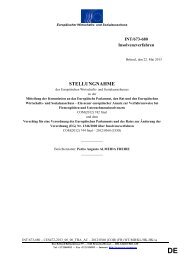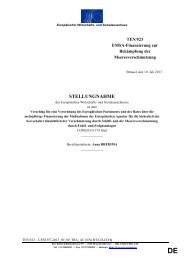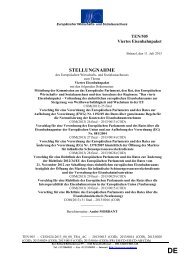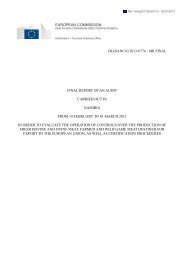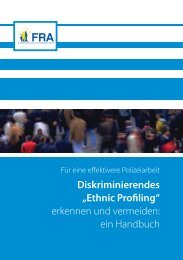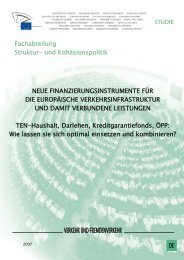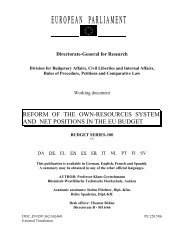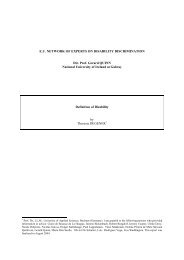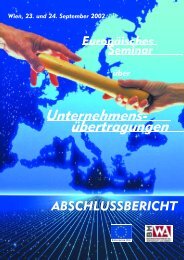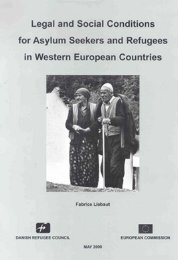Bulgaria - The social impact of seasonal migration
Bulgaria - The social impact of seasonal migration
Bulgaria - The social impact of seasonal migration
Create successful ePaper yourself
Turn your PDF publications into a flip-book with our unique Google optimized e-Paper software.
14<br />
since the late 1950s their number dramatically decreased. For 1956-65 less than 1 500<br />
people emigrated from the country, and in 1981-8 their number was even smaller - less<br />
than 700.<br />
As a whole, from 1880 to 1988, around 1 283 000 people emigrated from <strong>Bulgaria</strong>, while<br />
808 600 immigrated to the country (Kalchev 2001, 134).<br />
1.3. Migration movements between 1989-1997<br />
1989 was a year <strong>of</strong> dramatic transformations in both political and demographic terms.<br />
On 10 November 1989 the Communist government fell from power. Few months before<br />
that, there took place a large exodus <strong>of</strong> <strong>Bulgaria</strong>n Turks, leaving <strong>Bulgaria</strong> for Turkey. <strong>The</strong><br />
majority <strong>of</strong> the political scientists in <strong>Bulgaria</strong> admit that this unprecedented out<strong>migration</strong><br />
<strong>of</strong> <strong>Bulgaria</strong>n Turks, then called euphemistically "the big excursion", had a<br />
great <strong>impact</strong> upon the shattering <strong>of</strong> the Communist regime. Mass <strong>migration</strong> started in the<br />
spring <strong>of</strong> 1989, following vigorous, and sometimes bloody, protests from <strong>Bulgaria</strong>n Turks<br />
against the renaming campaign <strong>of</strong> 1984-5, during which <strong>Bulgaria</strong>n Turks were given<br />
<strong>Bulgaria</strong>n names. Termed in the Communist jargon a "revival process", this campaign,<br />
targeting a unified and homogeneous <strong>Bulgaria</strong>n nation through a forced Bulgarization <strong>of</strong><br />
ethnic Turks, was the push factor for their mass exit. 3 It was made possible by two<br />
government acts, Turkey asserting its readiness to accept all immigrants from <strong>Bulgaria</strong><br />
and <strong>Bulgaria</strong> opening its southern border. A significant pull factor was Turkey's<br />
willingness to receive these migrants, for whom it was given more than 250 million<br />
dollars in grants and loans by the US government and by the Council <strong>of</strong> Europe (Bobeva<br />
1994, 225). By the time Turkey closed the border unilaterally because <strong>of</strong> inability to cope<br />
with the <strong>migration</strong> wave (August 1989), around 360 000 <strong>Bulgaria</strong>n Turks succeeded in<br />
leaving <strong>Bulgaria</strong>. More than 1/3 <strong>of</strong> them returned to <strong>Bulgaria</strong> when the ban on Turkish<br />
names was revoked in December 1989. In 1990-1, an additional 150 000 <strong>Bulgaria</strong>n Turks<br />
left voluntarily for Turkey, forced by the deep economic decline which affected<br />
especially the ethnically mixed regions in <strong>Bulgaria</strong> (ibidem, 245-6). This decline was<br />
conditioned by the lowering <strong>of</strong> tobacco prices, the loss <strong>of</strong> Soviet block markets, the<br />
collapse <strong>of</strong> the construction sector, and by the loss <strong>of</strong> the privileges for the border<br />
regions, which had been a powerful economic tool for controlling e<strong>migration</strong>.<br />
Lifting the ban on free movement after 1989 produced large <strong>migration</strong> waves from the<br />
ethnic <strong>Bulgaria</strong>n population, too. Also compelled by the declining economy, and still<br />
experiencing travel as a form <strong>of</strong> political freedom, thousands <strong>of</strong> <strong>Bulgaria</strong>ns headed for<br />
Western Europe, USA, Canada, Australia and South Africa. 4 Public opinion asserted their<br />
number at several hundred thousands. Yet their free travel was hampered by a strict<br />
visa regime that served as a mechanism for controlling unwanted <strong>migration</strong>. Especially<br />
burdensome was the visa regime imposed by the EU countries given that <strong>Bulgaria</strong><br />
signed an association agreement with the EU in 1995 and started accession negotiations<br />
in 2000. Put on the EU "negative" visa list in 1993, it was not until April 2001 that <strong>Bulgaria</strong><br />
was removed from it and its citizens permitted a visa free entry for a short-term stay in<br />
the Schengen space. Although prior to that the majority <strong>of</strong> the applications for visas<br />
were ultimately approved, it was the time-consuming, expensive and <strong>of</strong>ten demeaning<br />
bureaucratic visa-granting procedures that effectively deterred <strong>Bulgaria</strong>ns from<br />
3 For its reasons see Ilchev 2000, 242-4<br />
4 Quoting newspaper data, Ilchev (2000, 266) writes that in the early 1990s some 300 000 ethnic <strong>Bulgaria</strong>ns<br />
left the country, heading for Western Europe, North America and South Africa



